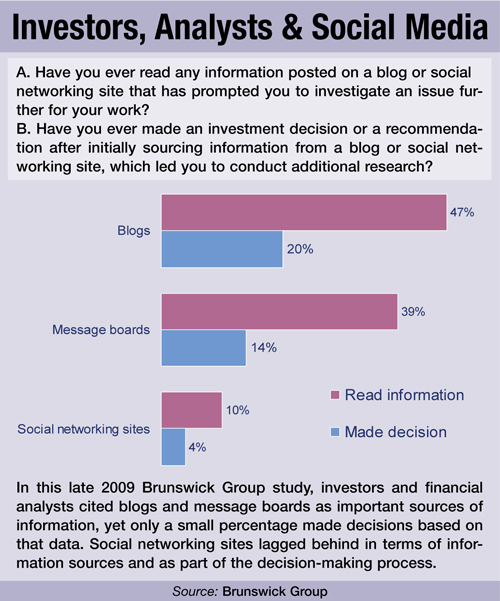As social media continues to explode, organizations and PR professionals have been quick to jump on the bandwagon. But one PR function hasn’t been so fast on the draw: financial communications. Organizations have been hesitant in deploying social media for financial communications mainly because of regulatory fears, similar to what healthcare is experiencing.
There are, however, “safe” ways to release both material and non-material financial content over social media platforms such as Twitter, Facebook and YouTube. In fact, some companies are doing just that—even distributing hard-core investor relations data via social media. Some examples include:
• As eBay last year posted live fourth-quarter results, it’s chief blogger, Richard Brewer-Hay, sent live updates via Twitter. EBay’s legal team even devised 140-character disclosure statements.
• Johnson & Johnson recently reported, for the first time, minutes from the company’s annual meeting via Twitter.
• EMC Corp. also uses Twitter to extend the reach for company news, while also tracking the opinions of employees, investors and peers.
• Dell publishes “Dell Shares,” an investor relations blog that provides insight into financial-related corporate activity, technology and products.
Not all organizations have the PR or legal resources of these large companies, but, says Rich Tauberman, head of MWW Group’s financial services practices, it’s not difficult to “dip your toe in the water” and begin communicating financial-related content to key stakeholders via social media. “People are scared to do it, but they shouldn’t be as nervous as they are,” says Tauberman. “As long as you are consistent in your messaging with full disclosure, you won’t have a problem.”

THE BARRIERS
Since the SEC announced its recognition of corporate blogs as public disclosure in July of last year, social media has been used quite effectively by PR, marketing and advertising professionals. However those wishing to push out financial related information are hesitant because of SEC guidelines that can result in penalties if breached.
Indeed, the SEC language can be confusing. On one hand the agency encourages companies to make financial information more available in a variety of locations and formats for better access—while on the other it says companies will be held liable for information that is posted on blogs, networks, communities and discussion forums.
No matter what, if a public company wants to use the social media outlets available, the SEC guidelines shouldn’t be ignored. Organizations that do want to take the plunge should read “Guidance on the use of Company Websites” to be clear on the rules of social media engagement.
The key to covering yourself? Be sure you link back to a safe harbor release, and write the release in plain English, says Leslie Loyett, VP at MWW’s Financial Relations Board.
Certainly though, not all financial-related content contains material information with possible SEC repercussions. For instance, Microvision implemented a multi-author blog for non-material information titled “The Displayground,” which links to media articles, product demonstrations and customer testimonials.
PROGRAMS IN PRACTICE
Need more evidence of successful social media efforts within financial communications? Consider financial services company Vanguard. According to PR spokesperson Linda Wolohan, Vanguard terms its social media efforts as “investor education, serving valued content to investors and other important stakeholders.”
The company has a blog, with several subject-matter expert contributors, that is hosted on its Web site; videos featuring outside experts and Vanguard employees posted on YouTube; and a Facebook page (currently with 8,300 fans) that posts economic news, tax reminders and investment portfolio advice, among other posts. “We keep with the tone of the platform,” says Wolohan. “We ask a lot of questions that hopefully will spark a discussion.”
To be sure, Vanguard is careful about what it posts on social media platforms. “Anything that we post ourselves is reviewed by our legal and compliance groups,” says Wolohan. Vanguard also has clear guidelines for fan posts on Facebook. Say a person writes a glowing testimonial on a Vanguard investment: “Regulations would forbid us from running that, and some people might wonder why it wouldn’t appear,” says Wolohan.
One area where Vanguard has yet to tread: Twitter. “It’s something that we’re looking very closely at, but we haven’t jumped in yet,” says Wolohan.
Genworth Financial is another financial services company that has taken the plunge into social media within its financial communications.
Its U.S. mortgage insurance arm has taken the lead in social media outreach, says Angela Spencer, Genworth’s digital marketing leader. Its chief blogger, Steve Richman, converses with a community of real estate brokers, agents and mortgage lenders. Richmond also tweets and has a Facebook page. “We integrate those three platforms to use as an education tool,” says Spencer. “It’s less about Genworth and more about how can we teach you.”
Genworth, says Spencer, has been cautious in its social media approach in terms of communicating financial messaging. It’s a strategy she recommends for any organization, along with the following tips on developing a social media plan:
• Have an engagement framework that helps you from end to end. What are your goals, how will you engage, address the risk, and how long will the process take from a legal and compliance perspective?
• Listen to your financial communities first. Identify and monitor the topics and influencers that matter to you.
• Learn from what they’re saying. Gather those insights, take those learnings and determine which channels you’ll use for each.
• Engage the audience productively. Break through the noise by building a relationship on trust and transparency. PRN
CONTACT:
Rich Tauberman, [email protected]; Leslie Loyet, [email protected]; Linda Wolohan, [email protected]; Angela Spencer, [email protected].
